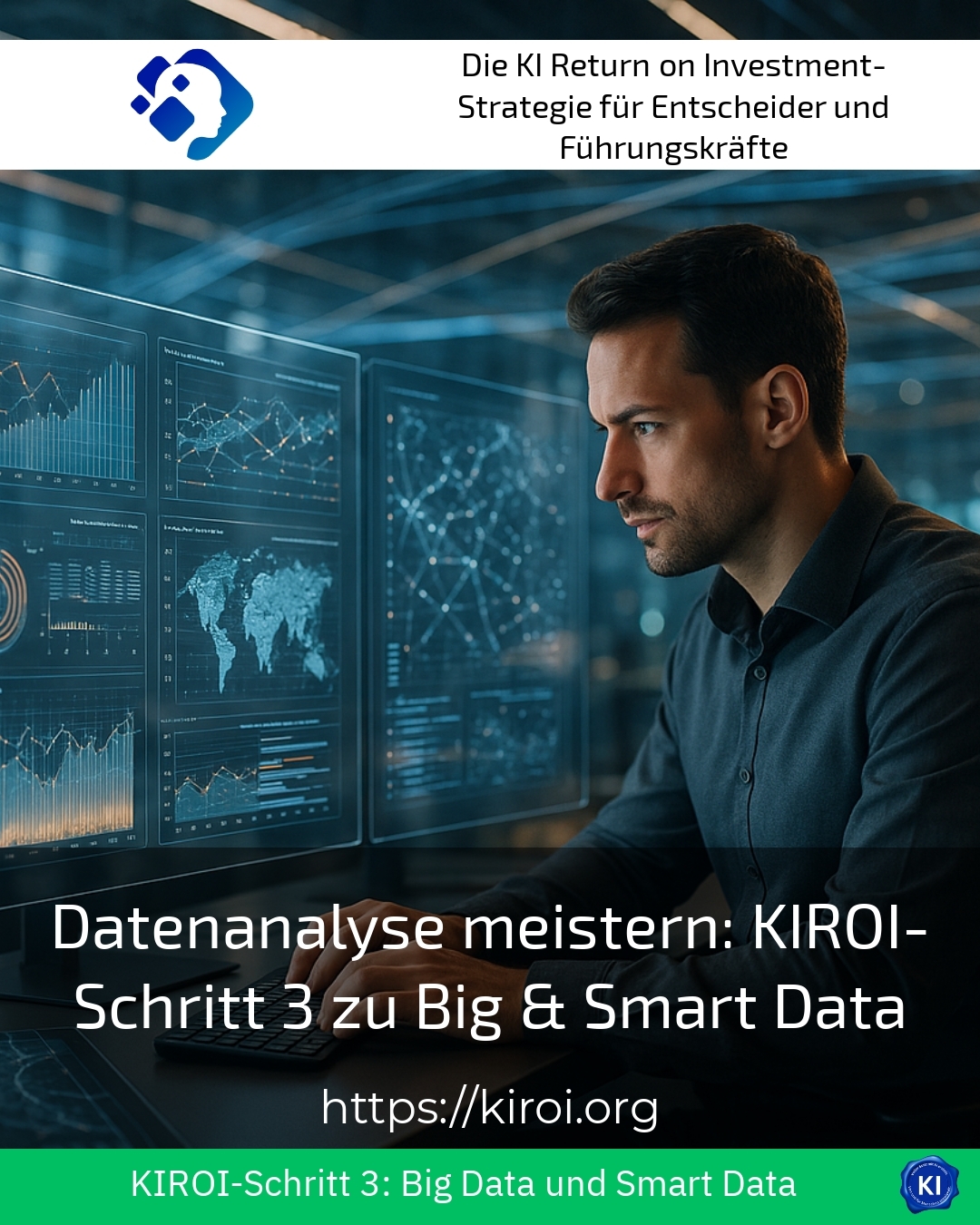Data analysis plays a central role in gaining essential insights from the growing volumes of data. Especially when dealing with large and complex data sets, it helps companies to optimise their processes and make well-founded decisions. As part of KIROI Step 3, which focuses on big and smart data, **data analysis** unfolds its full potential by extracting relevant information from extensive raw data and thus creating added value.
What does data analysis mean with Big & Smart Data?
Big data refers to the huge amounts of data that companies and organisations generate every day. This data comes from a wide variety of sources, such as sensors in industry, customer interactions in retail or movement data in the transport sector. The challenge is to process this flood of data in such a way that usable insights can be gained from the sheer mass. This is where data analysis comes in: It utilises various methods such as data mining, machine learning and statistical processes to uncover patterns, correlations and trends.
Smart data is based on big data and stands for intelligently filtered, quality-assured information. This means that not all data is analysed equally, but only those that offer added value. This creates a focussed database that helps companies to make faster and more precise decisions.
Practical examples of data analysis in the industrial and technical environment
In industry, data-analytical processes help with the early detection of machine faults, for example. Sensors constantly collect data on the condition of the systems. By analysing this information, failure risks can be identified at an early stage and maintenance can be planned in a targeted manner. This enables companies to reduce unplanned downtime and save costs.
Data analysis is also used in production to ensure production quality. Deviations can be recognised and immediately controlled using the process data. This enables reproducible quality and increases customer satisfaction.
In the field of logistics, intelligent data analyses optimise supply chains. By analysing inventory and transport data, stock levels can be kept to a minimum and delivery times improved. This allows companies to benefit from increased efficiency and flexibility.
BEST PRACTICE with one customer (name hidden due to NDA contract) The implementation of a smart monitoring system made it possible to analyse machine data in real time. As a result, the maintenance cycle could be dynamically adapted, which led to a significant reduction in downtime and at the same time extended the service life of the systems.
Important methods and tools for data analysis
Modern data analysis in Big & Smart Data projects comprises various methods. Descriptive analyses show what has happened, while predictive analyses enable forecasts for future developments. Prescriptive analyses go one step further and provide recommendations for action.
Data visualisations such as heat maps, scatter plots or box plots help to understand complex relationships. This enables stakeholders to better understand which factors have a particular impact on company processes.
Machine learning also plays a crucial role. In projects for anomaly detection or fraud prevention, algorithms are trained to automatically recognise unusual patterns and initiate appropriate measures.
BEST PRACTICE with one customer (name hidden due to NDA contract) A manufacturing company used predictive data analysis to forecast failures of critical components at an early stage. Targeted readjustment of maintenance intervals minimised production interruptions and significantly reduced operating costs.
How does transruptions-Coaching support data analysis projects?
Many companies face the challenge of extracting the right added value from complex data volumes. This is where coaching can help, providing practical guidance through all phases of data analysis. This allows analysis questions to be clearly defined, suitable methods to be selected and results to be communicated effectively.
One focus is on empowering teams to deal with big and smart data. Topics such as data preparation, quality checks and visualisation are covered. In practice in particular, many clients report that structured support provides impetus for better utilisation of their data sets and gives them confidence when making decisions.
For example, coaching can help to clarify issues relating to data quality and data protection, which is particularly important for sensitive data. It also supports the development of competences for the sustainable integration of data projects into the company.
BEST PRACTICE with one customer (name hidden due to NDA contract) transruptions coaching helped a medium-sized company to develop a data strategy that organised the flood of data in a targeted manner and thus significantly increased the quality of information. This led to more efficient decision-making processes and better coordination between IT and specialist departments.
My analysis
Data analysis is at the heart of dealing with today's data volumes. Particularly in the context of Big & Smart Data, it shows how valuable insights can be gained from large, often confusing amounts of data. Companies benefit from the improved transparency of their processes, the optimisation of workflows and well-founded support for strategic decisions.
A holistic approach, ranging from data preparation and intelligent analysis methods to practical support through coaching, facilitates the successful handling of data. This ensures that data is not only collected, but also utilised in a targeted and beneficial way. The ability to analyse data is therefore increasingly becoming a competitive factor and provides sustainable support for digital transformation.
Further links from the text above:
Smart + Big Data | Artificial Intelligence
Intelligent data analysis methods for engineers
Big and smart data - from statistics to data analysis
Big data explained simply
Smart data: definition, application and difference to big data
Making decisions with smart data
Big and smart data - DLR research
Mastering data analysis: KIROI step 3 with big & smart data
Data analytics: Data and methods - Fraunhofer SCS
For more information and if you have any questions, please contact Contact us or read more blog posts on the topic Artificial intelligence here.















